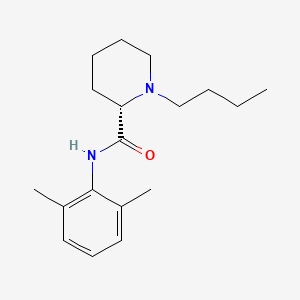Ferroptosis-centered Drug Response Information
General Information of the Drug (ID: ferrodrug0186)
| Name |
Levobupivacaine
|
||||
|---|---|---|---|---|---|
| Synonyms |
Levobupivacaine; 27262-47-1; (S)-bupivacaine; (-)-bupivacaine; L(-)-Bupivacaine; Levobupivacaine hydrochloride; Novabupi; (S)-1-Butyl-2',6'-pipecoloxylidide; L-(-)-bupivacaine; (2S)-1-butyl-N-(2,6-dimethylphenyl)piperidine-2-carboxamide; L-bupivacaine; Levobupivacaine free base; (S)-1-Butyl-N-(2,6-dimethylphenyl)piperidine-2-carboxamide; Bupivacaine, (s)-; L-(-)-1-Butyl-2',6'-pipecoloxylidide; Bupivacaine, (-)-; Bupivacaine (-)-form; Levobupivacaine (INN); A5H73K9U3W; CHEBI:6149; (2S)-1-butyl-N-(2,6-dimethylphenyl)-2-piperidinecarboxamide; 2-Piperidinecarboxamide, 1-butyl-N-(2,6-dimethylphenyl)-, (2S)-; 27262-47-1 (free base); LEVOBUPIVACAINE [INN]; Levobupivacaine [INN:BAN]; Levobupivacaina; (2~{S})-1-butyl-~{N}-(2,6-dimethylphenyl)piperidine-2-carboxamide; Novabupi (TN); NCGC00159482-02; (S)-(-)-Bupivacaine; UNII-A5H73K9U3W; 2',6'-Pipecoloxylidide, 1-butyl-, L-(-)-; SCHEMBL34537; BIDD:GT0471; LEVOBUPIVACAINE [VANDF]; GTPL7211; LEVOBUPIVACAINE [MART.]; CHEMBL1201193; DTXSID8048496; LEVOBUPIVACAINE [WHO-DD]; LEBVLXFERQHONN-INIZCTEOSA-N; (s)-1-butyl-n-(2,6-dimethylphenyl)-2-piperidinecarboxamide; HY-B0653; BUPIVACAINE (-)-FORM [MI]; BDBM50350791; BDBM50417951; MFCD00936851; s5181; AKOS016340525; DB01002; KS-5195; NCGC00016733-01; NCGC00159482-03; CAS-18010-40-7; CS-0009570; C07887; D08116; D87861; A818983; Q-100344; Q3272027; Z2242128693; (2S)-1-butyl-N-(2,6-dimethylphenyl)piperidine-2-carboximidic acid; ROPIVACAINE HYDROCHLORIDE MONOHYDRATE IMPURITY A [EP IMPURITY]; OJ0
Click to Show/Hide
|
||||
| Status |
Approved
|
||||
| Drug Type |
Small molecular drug
|
||||
| Structure |
 |
||||
| Formula |
C18H28N2O
|
||||
| IUPAC Name |
(2S)-1-butyl-N-(2,6-dimethylphenyl)piperidine-2-carboxamide
|
||||
| Canonical SMILES |
CCCCN1CCCCC1C(=O)NC2=C(C=CC=C2C)C
|
||||
| InChI |
InChI=1S/C18H28N2O/c1-4-5-12-20-13-7-6-11-16(20)18(21)19-17-14(2)9-8-10-15(17)3/h8-10,16H,4-7,11-13H2,1-3H3,(H,19,21)/t16-/m0/s1
|
||||
| InChIKey |
LEBVLXFERQHONN-INIZCTEOSA-N
|
||||
| PubChem CID | |||||
| TTD Drug ID | |||||
Full List of Ferroptosis Target Related to This Drug
Cystine/glutamate transporter (SLC7A11)
| In total 1 item(s) under this Target | |||||
| Experiment 1 Reporting the Ferroptosis-centered Drug Act on This Target | [1] | ||||
| Target for Ferroptosis | Suppressor | ||||
| Responsed Disease | Gastric cancer | ICD-11: 2B72 | |||
| Responsed Regulator | hsa-miR-489-3p (miRNA) | Driver | |||
| Pathway Response | Fatty acid metabolism | hsa01212 | |||
| Ferroptosis | hsa04216 | ||||
| Cell Process | Cell ferroptosis | ||||
| Cell proliferation | |||||
| In Vitro Model | GES-1 cells | Normal | Homo sapiens | CVCL_EQ22 | |
| HGC-27 cells | Gastric carcinoma | Homo sapiens | CVCL_1279 | ||
| SGC-7901 cells | Gastric carcinoma | Homo sapiens | CVCL_0520 | ||
| In Vivo Model |
Ten SCID nude mice aged 6-8 weeks were purchased from Vital River Laboratory Animal Technology Co., Ltd. (Beijing, China), and subcutaneously injected with SGC7901 cells (5 x 106 cells per mouse) in left back. One week after feeding, the mice were randomly divided into two groups, the control and treatment group. For the next 25 days, the mice in treatment group were injected with erastin (15 mg/kg intraperitoneally) or co-treated with 40 mol/kg body weight of levobupivacaine once a day. The body weight and tumor size were measured every 3 days.
Click to Show/Hide
|
||||
| Response regulation | Levobupivacaine-upregulated miR-489-3p enhanced ferroptosis of gastric cancer cells by targeting SLC7A11. MiR-489-3p was involved in levobupivacaine-induced ferroptosis of gastric cancer cells. Levobupivacaine/miR-489-3p/SLC7A11 axis attenuates gastric cancer cell proliferationin vitro. | ||||
Unspecific Target
| In total 1 item(s) under this Target | |||||
| Experiment 1 Reporting the Ferroptosis-centered Drug Act on This Target | [2] | ||||
| Responsed Disease | Lung cancer | ICD-11: 2C25 | |||
| Responsed Regulator | Cellular tumor antigen p53 (TP53) | Driver | |||
| Pathway Response | Ferroptosis | hsa04216 | |||
| Apoptosis | hsa04210 | ||||
| Cell Process | Cell ferroptosis | ||||
| Cell apoptosis | |||||
| Cell proliferation | |||||
| Cell migration | |||||
| Cell invasion | |||||
| In Vitro Model | A-549 cells | Lung adenocarcinoma | Homo sapiens | CVCL_0023 | |
| A427 cells | Lung carcinoma | Homo sapiens | CVCL_1055 | ||
| In Vivo Model |
Balb/c nude mice (n= 5, 4-week-old, male) were applied to detect the impact of levobupivacaine on tumor growth. Mice subcutaneously injected with 1 x 107 A549 cells were treated with levobupivacaine (40 umol/Kg) or equal volume saline. The tumor volume was remarked every 5 days and finished at 30 days after injection, followed by the analysis of volume (length (width/2)2) and weight.
Click to Show/Hide
|
||||
| Response regulation | Levobupivacaine could inhibit the proliferation and induce the apoptosis of non-small cell lung cancer (NSCLC) cells. Levobupivacaine was able to attenuate the invasion and migration in the cells. The treatment of levobupivacaine remarkably increased the levels of ROS, iron, and Fe2+ in NSCLC cells. Mechanically, levobupivacaine up-regulated the expression of p53 and induced ferroptosis by regulating p53 in NSCLC cells. | ||||
References
